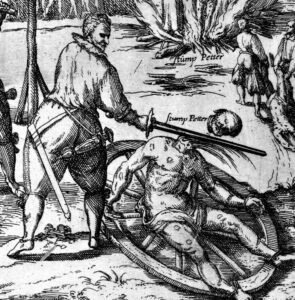By Beth Leermakers
There’s a bad moon on the rise. The moon will be full on October 31, and we know what that means — werewolves. Werewolves have been the villains in many stories and movies (Google “20 Best Werewolf movies to watch right now!”). Depending on the legend, werewolves are people who shape-shift into vicious, powerful wolves — or they’re human/wolf hybrids. In either case, werewolves are blood-thirsty creatures that savagely kill animals and people.

shape-shift into vicious, powerful wolves.
Photo courtesy of nprnews.org
Legendary Werewolves
Werewolf stories date back to ancient Mesopotamia, when they were mentioned in The Epic of Gilgamesh, a Sumerian epic poem written in 2700–2500 BC that may be the oldest written story. In one scene, Gilgamesh jilted a potential love interest because she’d turned her previous partner into a wolf.
In Greek mythology, Lycaon, king of Arcadia, tested the divinity of the god Zeus by serving him a meal made from the remains of a sacrificed boy. The furious Zeus punished Lycaon by turning him into a wolf. According to Ovid’s Metamorphoses: “His clothes became bristling hair, his arms became legs. He was a wolf, but kept some vestige of his former shape. There were the same grey hairs, the same violent face, the same glittering eyes, the same savage image.” The Lycaon story was apparently told to explain an extraordinary ceremony, the Lycaea, held in honor of Zeus Lycaeus. According to Plato, this ceremony involved human sacrifice and lycanthropy (assuming the form of a wolf).
In early Nordic folklore, The Saga of the Volsungs tells the story of a father and son who discovered wolf pelts that had the power to turn people into wolves for ten days. Wearing the pelts, the father and son transformed into wolves and went on a killing rampage in the forest. Their killing spree ended after the father attacked his son, who survived only because a kind raven gave the father a leaf with healing powers.
Several 16th century French serial killers claimed to have an ointment that turned them into wolves. After confessing to brutally murdering several children, two Frenchmen were burned to death at the stake in 1521. Another Frenchman who, as a wolf, killed children and ate them, was also burned at the stake, according to legend. Burning was believed to be one of the few ways to kill a werewolf.

According to folklore, Peter Stubbe, a 16th century German farmer, turned into a wolf at night and killed at least 12 people. Hunters claimed they saw Stubbe shapeshift from a wolf to human form. He claimed he had a magic belt of wolf fur that let him turn into a wolf at will. Under torture, Stubbe confessed to savagely killing children and adults. He was decapitated and burned at the stake on Halloween 1859. Some researchers believe Stubbe was innocent and only confessed because of the brutal torture. He may have suffered from clinical lycanthropy, a rare psychological condition that causes people to believe they’re changing into a wolf.
The Transformation
Although the transformation into a werewolf is often blamed on the full moon, there have been many different explanations throughout the centuries. Ancient Greeks believed a person could turn into a wolf by eating the meat of a wolf mixed with human flesh, and the condition was irreversible. Centuries later, the transformation was variously attributed to being cursed, being conceived under a new moon, eating certain herbs, sleeping under the full moon on Friday, or drinking water that has been touched by a wolf.
According to some legends, people shape-shifted when they wore an enchanted sash or a protective cloak made of wolf skin. They had to remove the magical pelt at daybreak and hide it. If someone found and took the pelt, the werewolf-in-human-form could be killed. According to other stories, people became wolves after being scratched or bitten by a werewolf.
A Medical Explanation?
In 1725 a young boy, dubbed “a wild boy,” was found naked and crawling on all fours in Germany. The boy, who couldn’t talk or walk upright and ate with his hands, was believed to have been raised by wolves. Named Peter, the wild boy was treated like a side-show freak and was eventually sent to England to be a “pet” for the courts of King George I and King George II. Although he was considered a wolf-boy, Peter probably suffered from Pitt-Hopkins syndrome — a medical condition that causes lack of speech and stunted intelligence.
Two medical conditions mimic the werewolf appearance:
Hypertrichosis (aka “werewolf syndrome”). In very rare cases, a person is afflicted with a genetic mutation that causes unusually long hair to cover the face and entire body, except the palms and soles of the feet. There have only been about 50 extreme cases of hypertrichosis reported since medieval times.
Porphyria. This rare condition is characterized by extreme sensitivity to light (thus encouraging its sufferers to only go out at night), seizures, anxiety and other symptoms.
Of course neither condition turns someone into a werewolf. However, centuries ago, when many people believed in witches and magic, these conditions may have contributed to werewolf myths.
Happy Halloween!
